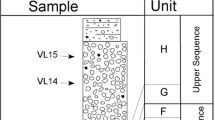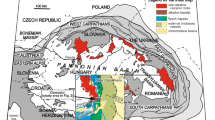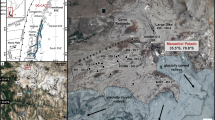Abstract
Deccan Trap magmas may have erupted through multiple centers, the most prominent of which may have been a shield volcano-like structure in the Western Ghats area. The lavas are predominantly tholeiitic; alkalic mafic lavas and carbonatites are rare. Radioisotope dating, magnetic chronology, and age constraints from paleontology indicate that although the eruption started some 68 Ma, the bulk of lavas erupted at around 65–66 Ma. Paleomagnetic constraints indicate an uncertainty of ± 500,000 years for peak volcanic activity at 65 m.y. in the type section of the Western Ghats. Maximum magma residence times were calculated in this study based on growth rates of “giant plagioclase” crystals in lavas that marked the end phase of volcanic activity of different magma chambers. These calculations suggest that the > 1.7 km thick Western Ghats section might have erupted within a much shorter time interval of ∼ 55,000 years, implying phenomenal eruption rates that are orders of magnitude larger than any present-day eruption rate from any tectonic environment. Other significant observations/conclusions are as follows: (1) Deccan lavas can be grouped into stratigraphic subdivisions based on their geochemistry; (2) While some formations are relatively uncontaminated others are strongly contaminated by the continental crust; (3) Deccan magmas were produced by 15–30% melting of a Fe-rich lherzolitic source at ∼ 3–2 GPa; (4) Parent magmas of the relatively uncontaminated Ambenali formation had a primitive composition with 16%MgO, 47%SiO2; (5) Deccan magmas were generated much deeper and by significantly more melting than other continental flood basalt provinces; (6) The erupted Deccan tholeiitic lavas underwent fractionation and magma mixing at ∼ 0.2 GPa. The composition and origin of the crust and crust/mantle boundary beneath the Deccan are discussed with respect to the influence of Deccan magmatic episode.
Similar content being viewed by others
References
Allegre C J, Birck J L, Capmas F and Courtillot V 1999 Age of the Deccan Traps using187Re-187 Os systematics;Earth Planet. Sci. Lett. 170 197–204
Baksi A K 1994 Geochronological studies on whole-rock basalts, Deccan Traps: evaluation of the timing of volcanism relative to the K-T boundary;Earth Planet. Sci. Lett. 121 43–56
Basu A R, Renne P R, Dasgupta D K, Teichmann F and Poreda R J 1993 Early and late alkali igneous pulses and a high-3 He plume origin for the Deccan flood basalts;Science 261 902–906
Beane J E 1988 Flow stratigraphy, chemical variation and petrogenesis of Deccan flood basalts, Western Ghats, India,Ph.D. Dissertation, Washington State University, Pullman, 576p.
Beane J E and Hooper P R 1988 A note on the picrite basalts of the Western Ghats, Deccan Traps, India;Mem. Geol. Soc. India 10 117–133
Beane J E, Turner C A, Hooper P R, Subbarao K V and Walsh J N 1986 Stratigraphy, composition and form of the Deccan basalts, Western Ghats, India;Bull. Volcanol. 48 61–83
Bhattacharji S, Chatterjee N, Wampler J M and Gazi M 1994 Mafic dikes in Deccan volcanics—indicator of India intraplate rifting, crustal extension and Deccan flood basalt volcanism. In:Volcanism, ed. K V SubbaraoGeol. Soc. India 253–276
Bose M K 1980 Alkaline magmatism in the Deccan volcanic province;J. Geol. Soc. India 21 317–329
Campbell I H 1985 The difference between oceanic and continental tholeiites: a fluid dynamic explanation;Contrib. Mineral. Petrol. 20 244–267
Campbell I H and Griffiths R W 1990 Implications of mantle plume structure for the evolution of flood basalts;Earth Planet. Sci. Lett. 99 79–93
Cashman K V and Marsh B D 1988 Crystal size distribution, CSD, in rocks and the kinetics and dynamics of crystallization.III. Makaopuhi lava lake;Contrib. Mineral. Petrol. 99 292–305
Chandrasekharam D, Vasselli O, Sheth H C and Keshav S 2000 Petrogenetic significance of ferro-enstatite orthopyroxene in basaltic dikes from the Tapi rift, Deccan flood basalt province, India;Earth Planet. Sci. Lett. 179 469–476
Chatterjee S and Rudra D K 1992 KT events in India: impact, rifting, volcanism and dinosaur extinction;Memoir of the Queensland Museum 39 489–532
Coffin M F and Eldholm O 1993 Large igneous provinces;Sci. Am. 269 42–49
Cohen T H and Sen G 1994 Fractionation and ascent of Deccan Trap magmas: An experimental study at 6 kilobar pressure; InVolcanism (ed) K V Subbarao,Geol. Soc. India 173–186
Courtillot V, Besse J, Vandamme D, Montigny R, Jaeger J J and Capetta H. 1986 Deccan flood basalts at the Cretaceous/ Tertiaryboundary; EarthPlanet. Sci. Lett. 80 361–374
Cox K G and Mitchell C 1988 Importance of crystal settling in the differentiation of Deccan Trap basaltic magmas;Nature 333 447–449
Cox K G and Hawkesworth C J 1985 Geochemical stratigraphy of the Deccan Traps at Mahabaleshwar, Western Ghats, India, with implications for open system magmatic processes;J. Petrol. 26 355–377
Cox K G 1999 The role of mantle plumes in the development of continental drainage patterns. In:Deccan Volcanic Province, (ed.) K. V. SubbaraoMem. Geol. Soc. India 43 607–618
Crookshank H 1936 Geology of the northern slopes of the Satpuras between the Morand and Sher rivers;Geol. Surv. India Mem. 66
De A 1964 Iron-titanium oxides and silicate minerals of the alkali olivine basalts, tholeiites and acidic rocks of the Deccan Trap series and their significance. Int. geol. Congress Report 22nd Session, Pt III, 126 New Delhi
De A 1974 Silicate liquid immiscibility in the Deccan Traps and its petrogenetic significance;Bull. Geol. Soc. Am. 85 471–474
Deshmukh S S, Aramaki S, Shimizu N, Kurasawa N and Konda T 1977 Petrography of the basalt flows exposed along Mahabaleshwar and Amboli sections in Western Ghats, India;Geol. Surv. India, Rec. 108 81–103
Dessai A G and Vaselli O 1999 Petrology and geochemistry of xenoliths in lamprophyres from the Deccan Traps: implications for the nature of the deep crust boundary in western IndiaMineralogical Magazine 63 703–708
Devey C W and Cox K G 1987 Relationships between crustal contamination and crystallization in continental flood basalt magmas with special reference to the Deccan Traps of Western India;Earth Planet. Sci. Lett. 84 59–68
Duncan R A and Pyle D G 1988 Rapid eruption of the Deccan flood basalts at the Cretaceous/Tertiary boundary;Nature 333 841–843
Duncan R A and Richards M A 1991 Hotspots, mantle plumes, flood basalts, and true polar wander;Rev. Geophys. 29 31–50
Fisk M R, Upton B G J, Ford C E and White W M 1988 Geochemical and experimental study of the genesis of magmas of Reunion island, Indian Ocean;J. Geophys. Res. 93 4933–4950
Gangopadhyay A 2000 An experimental petrologic study of basalts from selected formations of the Deccan Traps, India; M.S. Thesis, Florida International University, 105p
Griffiths R W and Campbell I H 1990 Stirring and structure in mantle plumes;Earth Planet. Sci. Lett. 99 66–78
Griffiths R W and Campbell I H 1991a On the dynamics of long-lived plume conduits in the convecting mantle;Earth Planet. Sci. Lett. 103 214–227
Griffiths R W and Campbell I H 1991b Interaction of mantle plume heads with the Earth’s surface and onset of smallscale convection;J. Geophys. Res. 96 18295–18310
Gupte R B 1995 Comments on the research note “On the origin of bole beds in Deccan Traps” by P M Inamdar and D Kumar;J. Geol. Soc. India 45 607–608
Gwalani L, Rock N M S, Chang W-J and Fernandez F 1993 Alkaline rocks and carbonatites of Amba Dongar and adjacent areas, Deccan Igneous Province, Gujarat, India. 1. Geology, petrography, and Petrochemistry;Mineral. Petrol. 47 219–253
Gwalani L G and others 1995 Alkaline and tholeiitic dyke swarm associated with Amba Dongar and Phenai Mata complexes, Chhota Udaipur alkaline sub-province, western India;J. Geol. Soc. India Mem 33 391–423
Hirose K and Kushiro I 1993 Partial melting of dry peridotites at high pressures: Determination of compositions of melts segregated from peridotite using aggregates of diamond;Earth Planet. Sci. Lett. 114 477–489
Hooper P and others 1988 The Giant Plagioclase Basalts (GPBs) of the Western Ghats, Deccan Traps;Mem. Geol. Soc. India 10 135–144
Hooper P R 1999 The winds of change, The Deccan Traps: A personal perspective. In:Deccan Volcanic Province (ed.) K V SubbaraoMem. Geol. Soc. India 43 153–165
Inamdar P M and Kumar D 1994 On the origin of bole beds in Deccan Traps;J. Geol. Soc. India 44 331–334
Inamdar P 1995 Reply to comments by R B Gupte:J. Geol. Soc. India 45, 608–609
Jaques A L and Green D H 1980 Anhydrous partial melting of peridotite at 0–15 kb pressure and the genesis of tholeiitic basalts;Contrib. Mineral. Petrol. 73 287–310
Kaila K L 1988 Mapping the thickness of Deccan Trap flows in India from DSS studies and inferences about a hidden Mesozoic basin in the Narmada-Tapti region. In:Deccan Flood Basalts (ed.) K. V. SubbaraoMem. Geol. Soc. India 10 91–116
Kellogg L H, Hager B H and van derHilst R D 1999 Compositional stratification in the deep mantle;Science 283 1881–1884
Khadri S F R, Subbarao K V and Walsh J N 1999 Stratigraphy, form, and structure of the East Pune basalts, western Deccan Basalt province, India. In:Deccan Volcanism (ed.) K. V. SubbaraoMem., Geol. Soc. India 43 179–202
Klein E and Langmuir C H 1987 Global correlations of ocean ridge basalt chemistry with axial depth and crustal thickness;J. Geophys. Res. 92 8089–80115
Krishnamurthy P and Cox K G 1977 Picrite basalts and related lavas from the Deccan Traps of western India;Contrib. Mineral. Petrol. 62 53–75
Krishnamurthy P, Pande K, Gopalan K and Macdougall J D 1988 Upper mantle xenoliths in alkali basalts related to Deccan Trap volcanism. InDeccan Flood Basalts, (ed.) K. V. SubbaraoGeol. Soc. India Mem. 10 53–67
Krishnamurthy P, Gopalan K and Macdougall J D 2000 Olivine compositions in picrite basalts and the Deccan volcanic cycle;J. Petrol. 41 1057–1069
Krishnan M S 1982Geology of India and Burma, 6th edition, (Delhi.: CBS Publishers and Distributors).
Lassiter J C and DePaolo D J 1997 Plume/lithosphere interactions in the genesis of continental and oceanic flood basalts: chemical and isotopic constraints; InLarge igneous provinces: continental, oceanic, and planetary flood volcanism; (eds) J J Mahoney and M F Coffin; Am. Geophys. Union Monograph100 335–356
Lightfoot P C, Hawkesworth C J, Devey C W, Rogers N W and van CalsterenP W C 1990 Source and differentiation of Deccan Trap lavas: implications of geochemical and mineral chemical variations;J. Petrol. 31 1165–1200
Mahadevan T M and Subbarao K V 1999 Seismicity of the Deccan volcanic province-an evaluation of some endogenous factors. In:Deccan Volcanism, (ed.) K V Subbarao,Mem. Geol. Soc. India 43 453–484
Mahoney J and others 1982 Origin of the Deccan Trap flows at Mahabaleshwar inferred from Nd and Sr isotopic and chemical evidence;Earth Planet. Sci. Lett. 60 47–60
Mahoney J J 1988 Deccan Traps. In:Continental flood basalts, (ed) Macdougall J D (Dordrecht: KluwerAcademic), pp 151–194
Mahoney J, Macdougall J D, Lugmair G W, Gopalan K and Krishnamurthy P 1985 Origin of contemporaneous tholeiite and K-rich alkalic lavas: a case study from the Northern Deccan plateau;Earth Planet. Sci. Lett. 73 39–53
Mahoney J, Sheth H C, Chandasekharam D and Peng Z X 2000 Geochemistry of flood basalts of the Toranmal section, Northern Deccan Traps, India: implications for regional Deccan stratigraphy;J. Petrol. 41 1099–1120
McLean D M 1985 Deccan Trap mantle degassing in the terminal Cretaceous marine extinctions;Cretaceous Research 6 235–259
Melluso L L, Beccaluva R, Brotzu A, Gregnanin A, Gupta K, Morbidelli L and Traversa G G 1995 Constraints on the mantle sources of the Deccan Traps from the petrology and geochemistry of Basalts of Gujarat state, western India;J. Petrol. 36 1393–1432
Mitchell C H and Widdowson M 1991 A geological map of the southern Deccan Traps, India and its structural implications;J. Geol. Soc. London 148 495–505
Najafi S, Cox K G and Sukeshwala R N 1981 Geology and geochemistry of the basalt flows, Deccan Traps, of the Mahad-Mahabaleshwar section, India; In:Volcanism and related provinces in other parts of the world, (eds.) K V Subbarao and R N Sukeshwala;Mem. Geol. Soc. India 3 300–315
Pankov V and others 1994 Mineral and melt inclusions in the Giant Plagioclase phenocrysts of Deccan Basalts, Western Ghats, India: Some comparisons with plagioclases of intrusive Siberian Traps and implications on the physicochemical conditions during magmatic evolution; In:Volcanism, (ed) K V Subbarao,Geol. Soc. India 187–199
Pant P R and others 1999 Significant inferences on deep crustal structure of Deccan Trap region from spectral analyses of Bouguer anomalies;J. Geol. Soc. India 53 315–328
Peng Z X and others 1994 A role for lower continental crust in flood basalt genesis? Isotopic and incompatible element study of the lower six formations of the western Deccan Traps;Geochim. Cosmochim. Acta 58 267–288
Peng Z X and Mahoney J J 1995 Drillhole lavas from the northwestern Deccan Traps, and the evolution of the Reunion hotspot mantle;Earth Planet. Sci. Lett. 134 169–185
Peng Z X and others 1998 Basalts of the northeastern Deccan Traps, India: isotopic and elemental geochemistry and relation to southwestern Deccan Trap stratigraphy;J. Geophys. Res. 103 29843–29865
Ravi Shanker 1988 Heat flow map of India and its geological and economic significance;Indian Mineral. 42 89–110
Ray J S,.Trivedi J R and Dayal A M 2000 Strontium isotope systematics of Amba Dongar and Sung Valley carbonatitealkaline complexes, India: evidence for liquid immiscibility, crustal contamination and long-lived Rb/Sr enriched mantle sources;J. Asian Earth Sci. 18 585–594
Richards M A, Duncan R A and Courtillot V E 1989 Flood basalts and hot spot tracks: Plume heads and tails;Science 246 103–107
Sen G 1980 Mineralogical variations in the Delakhari Sill, Deccan Trap intrusion, Central India;Contrib. Mineral. Petrol. 75 71–78
Sen G 1983 Deccan Trap intrusion: Magma mixing in the Chakhla-Delakhari sill, Chhindwara district, Madhya Pradesh;J. Geol. Soc. India 24 381–393
Sen G 1986 Mineralogy and petrogenesis of the Deccan Trap lava flows around Mahabaleshwar, India;J. Petrol. 27 627–663
Sen G 1988 Possible depth of origin of primary Deccan tholeiite magma;Mem. Geol. Soc. India 10 34–51
Sen G and Cohen T H 1994 Deccan intrusion, crustal extension, doming and the size of the Deccan-Reunion plume head; InVolcanism, (ed) K V Subbarao,Geol. Soc. India 201–216
Sen G 1995 A simple petrologic model for the generation of Deccan Trap magmas;Int. Geol. Rev. 37 825–850
Sen G 2001Earth’s Materials: Minerals and Rocks (Upper Saddle River, N.J., Prentice-Hall), 542 pp
Sethna S F and Sethna B S 1988 Mineralogy and petrogenesis of Deccan Trap basalts from Mahabaleshwar, Igatpuri, Sagar, and Nagpur areas, India. In:Deccan Flood Basalts, (ed) K V Subbarao,Mem. Geol. Soc. India 10 69–90
Sethna S F and Mousavi M 1994 Geology and petrochemistry of Deccan Traps along a part of the western coastal tract. In:Volcanism, (ed) K V Subbarao 233–252
Sheth H C 1999 A historical approach to continental flood basalt volcanism: insights into pre-volcanic rifting, sedimentation, and early alkaline magmatism;Earth Planet. Sci. Lett. 168 19–26
Simonetti A, Bell K and Viladkar S G 1995 Isotopic data from the Amba Dongar carbonatite complex, west-central India: evidence for an enriched mantle source;Chem. Geol. 122 185–198
Subbarao K V and Hooper P R 1988 Reconnaissance map of the Deccan Basalt Group in the Western Ghats, India; In:Deccan Flood Basalts, (ed) K V Subbarao,Mem. Geol. Soc. India 10
Subbarao K V and others 1994 Stratigraphy and structure of parts of the central Deccan basalt province: eruptive models; InVolcanism, (ed) K V Subbarao,Geol. Soc. India 321–332
Sukheswala R N and Poldervaart A 1958 Deccan basalts of the Bombay area, India:Bull. Geol. Soc. Am. 69 1475–1494
Takin M 1966 An interpretation of the positive gravity anomaly over Bombay on the west coast of India;J. Astr. Soc. Geophys. Suppl. 11 527–533
Turner S and Hawkesworth C 1995 The nature of subcontinental mantle: constraints from the major-element composition of continental flood basalts;Chem. Geol. 120 295–314
Venkatesan T R, Pande K and Gopalan G 1993 Did Deccan volcanism pre-date the Cretaceous/Tertiary transition?Earth Planet. Sci. Lett. 119 181–189
Walker GPL 1999 Some observations and interpretations on the Deccan Traps; In:Deccan Volcanic Province, (ed) K V Subbarao,Mem. Geol. Soc India 43 367–395
Watson E B 1982 Basalt contamination by continental crust: some experiments and models;Contrib. Mineral. Petrol. 80 73–87
Watts A B and Cox K G 1989 The Deccan Traps: an interpretation in terms of progressive flexure in response to a migrating load;Earth Planet. Sci. Lett. 93 85–97
West W D 1958 The petrography and petrogenesis of fortyeight flows of Deccan Traps penetrated by borings in western India;Trans. Nat. Inst. Sci. India 4 1–56
West W D 1981 The duration of Deccan Trap volcanicity;Mem. Geol. Soc. India 3 277–278
White R S and McKenzie D 1995 Mantle plumes and flood basalts;J. Geophys. Res. 100 17543–17585
Widdowson M and Mitchell C 1999 Large-scale stratigraphical, structural, and geomorphological constraints for earthquakes in the southern Deccan Traps, India: the case for denudationally-driven seismicity;Mem. Geol. Soc. India 43 425–452
Wilkins A, Subbarao K V, Ingram G and Walsh J N 1994 Weathering regimes within Deccan basalts. In:Volcanism, (ed) K V Subbarao, (New Delhi: Wiley Eastern) 217–231
Wilson M 1989Igneous Petrogenesis, (London: Unwin Hyman).
Author information
Authors and Affiliations
Rights and permissions
About this article
Cite this article
Sen, G. Generation of Deccan Trap magmas. J Earth Syst Sci 110, 409–431 (2001). https://doi.org/10.1007/BF02702904
Issue Date:
DOI: https://doi.org/10.1007/BF02702904




